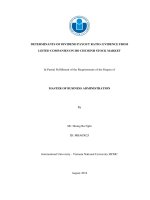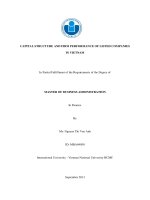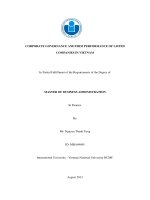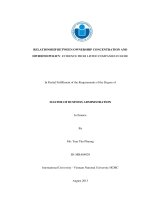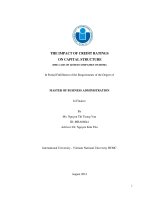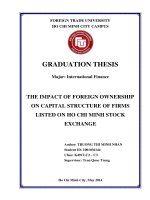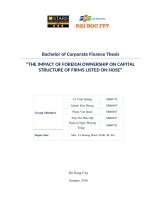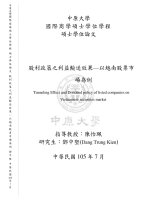The effect of foreign ownership on dividend policy the case of listed companies on hose
Bạn đang xem bản rút gọn của tài liệu. Xem và tải ngay bản đầy đủ của tài liệu tại đây (1.67 MB, 87 trang )
VIETNAM NATIONAL UNIVERSITY – HO CHI MINH CITY
INTERNATIONAL UNIVERSITY
SCHOOL OF BUSINESS
THE EFFECT OF FOREIGN OWNERSHIP ON DIVIDEND POLICY:
THE CASE OF LISTED COMPANIES ON HOSE
In Partial Fulfillment of the Requirement of the Degree of
Master of Business Administration
In the School of Business Administration
Student Name and ID: DONG QUANG VINH – MBA05053
Advisor: NGUYEN KIM THU, Ph.D.
Ho Chi Minh city, Vietnam
August 2014
INTERNATIONAL UNIVERSITY
SOCIALIST REPUBLIC OF VIETNAM
SCHOOL OF BUSINESS
Independence - Freedom - Happiness
ASSURANCE QUALIFIED THESIS
Student’s Name:
DONG QUANG VINH
Student ID:
MBA05053
Title of Thesis:
The effect of Foreign Ownership on Dividend payout policy: The case
of listed companies on HOSE
Advisor:
Ph.D. NGUYEN KIM THU
I assure that the content of this thesis has been qualified all requirements for a
research paper and able to participate in the final thesis defense.
Approved by
The Effect of Foreign Ownership on Dividend Policy
The case of listed companies on HOSE
In Partial Fulfillment of the Requirements of the Degree of
MASTER OF BUSINESS ADMINISTRATION
In Finance
by
Mr: DONG QUANG VINH
ID: MBA05053
International University - Vietnam National University HCMC
August 2014
Under the guidance and approval of the committee, and approved by all its members, this
thesis has been accepted in partial fulfillment of the requirements for the degree.
Approved:
---------------------------------------------Chairperson
---------------------------------------------Committee member
---------------------------------------------Committee member
--------------------------------------------Committee member
--------------------------------------------Committee member
--------------------------------------------Committee member
ACKNOWLEDGEMENT
Foremost, I would like to express my sincere gratitude to my advisor Prof. Nguyen Kim
Thu for the continuous support of my study and research, for her patience, motivation,
enthusiasm, and immense knowledge. Her guidance helped me in all the time of research and
writing of this thesis.
Besides my advisor, I would like to thank to all of my lecturers in the MBA course. I
have learned so much knowledge not only in my major but also related skills to carry out this
thesis. Moreover, I would like to express my sincere thank to the members of the Committee
for giving valuable comments to improve the research.
I thank to my fellow classmate for the stimulating discussions, for the sleepless nights
we were working together. Last but not the least, I would like to thank to my family: my
parent and my wife for their support and encouragement.
Plagiarism Statements
I would like to declare that, apart from the acknowledged references, this thesis either
does not use language, ideas, or other original material from anyone; or has not been
previously submitted to any other educational and research programs or institutions. I fully
understand that any writings in this thesis contradicted to the above statement will
automatically lead to the rejection from the MBA program at the International University –
Vietnam National University Ho Chi Minh City.
Copyright Statement
This copy of the thesis has been supplied on condition that anyone who consults it is
understood to recognize that its copyright rests with its author and that no quotation from the
thesis and no information derived from it may be published without the author‟s prior
consent.
© DONG QUANG VINH/ MBA05053/2014-2015
TABLE OF CONTENTS
ABSTRACT………………………………………………………………………………. i
CHAPTER 1: INTRODUCTION
1.1. Background of the Study……………………………………………………………..1
1.2. Problem Statement
………………………………………………………………2
1.3. Rationale of the Research…………………………………………………………….3
1.4. Research Question of the study……………………………………………………… 4
1.5. Research Objectives………………………………………………………………….. 4
1.6. Scope and Limitation of the Research ……………………………………………… 4
1.7. Research Methodology ………………………………………………………………. 4
1.8. Thesis Structure ……………………………………………………………………… 5
CHAPTER 2 – LITERATURE REVIEW……………………………………………….. 6
2.1 Definition of Dividend…………………………………………………………………. 6
2.2 Dividend policy theories………………………………………………………………. 7
2.2.1Clienteles theory…………………………………………………………… 7
2.2.2 Bird in hand ………………………………………………………………… 8
2.2.3 Signaling theory ……………………………………………………………. 9
2.2.4Pecking order theory ………………………………………………………. 10
2.2.5 Transaction cost theory ……………………………………………………. 11
2.2.6 Agency cost theory …………………………………………………………. 12
2.2.7 Adverse Selection theory…………………………………………………… 14
2.3 Determinants of Dividend payout ratio……………………………………………… 16
2.3.1 Dividend and Return on Assets …………………………………………… 16
2.3.2 Dividend and Leverage ……………………………………………………. 16
2.3.3 Dividend and Firm size ……………………………………………………. 17
2.3.4 Dividend and Growth of sales …………………………………………….. 18
2.3.5 Dividend and Profitability ………………………………………………… 18
2.3.6 Dividend and free cash flow ………………………………………………. 19
2.4 Agency theory empirical studies on the relationship between foreign ownership and
dividend policy:
2.4.1 Agency theory and Expectation of Investors..…………………………….. 21
2.4.2 Empirical studies on the relationship between dividend payout policy and
foreign ownership………………………………………………………………………….. 23
CHAPTER 3 –FOREIGN OWNERSHIP OF LISTED COMPANIES IN HO CHI MINH
STOCK EXCHANGE FROM 2008-2012…………………………………………………………
25
3.1Top holdings of foreign investors, in companies………………………………………25
3.2 Top holding of foreign investors, in industries…………………………………….. 26
CHAPTER 4–RESEARCH METHODOLOGY…………………………………………29
4.1 Data Collection ………………………………………………………………………. 29
4.2Model .………………………………………………………………………………….29
4.2.1 Control variables ……………………………………………………………………29
4.2.2 Independent variable …………………..……………………………………………31
4.2.3 Dependent variable………….………….……………………………………………32
4.2.4 Model…………………………………………………………………………………. 32
4.3 Descriptive Methods…………………..……………………………………………….. 32
4.3.1 Descriptive Statistic………….………………………………………………. 32
4.3.2 Pearson Correlation test…………………………………………………….. 32
4.3.3 Regression Model…………….……………………………………………… 33
CHAPTER 5: DATA ANALYSIS …….…………………………………………………38
5.1 Descriptive Statistic……………………..………………………………………………38
5.2 Pearson Correlation …………………………………………………………………. 41
5.3 Analysis of the results………………………………………………………………….. 43
5.3.1 Pooled OLS ………………………………………………………………… 43
5.3.2 Fix effect Model ..…………………..……………………………………….45
5.3.3 Random effects model…….……………………………………………….. 45
5.4 Specification Test………………….…………………………………………………. 45
5.4.1 F test………………………………………………………………………… 46
5.4.2 Hausman test………….……………………………………………………… 47
5.4.3 Random effect model without independent variables …………………….. 48
5.4.4 Heteroskedascity……………….…………………………………………….. 49
5.4.5 Heteroskedascity robust F statistic..……………………………………….. 50
5.5 Discussion of result……………………………………………………………………. 52
CHAPTER 6: CONCLUSION AND RECOMMENDATION…………………………. 54
6.1. Conclusion
……………………………………………………………………………54
6.2. Recommendation ……….……………………………………………………………..55
LIST OF ABBREVIATIONS
Abbreviation
Meaning
HOSE
Ho Chi Minh Stock Exchange
DPR
Dividend payout ratio
FEM
Fixed effect model
REM
Random Effects model
Pooled OLS
Pooled Ordinary Least Square
LIST OF TABLES
Table 1: Summary of expected relationship of DPR with independent variables
Table 2: Summary of foreign ownership in the Ho Chi Minh Stock Exchange, by Company
Table 3: Summary of foreign ownership in the Ho Chi Minh Stock Exchange, by Industry
Table 4: Descriptive Statistic
Table 5: Companies that pay cash dividend even though they have negative EPS
Table 6: Company that maintain cash dividend as EPS declines
Table 7: Pearson correlation among variables.
Table 8: Pooled OLS
Table 9: Fixed effect model
Table 10: Random effect model
Table 11: F-test
Table 12: Hausman test
Table 13: Random Effects after eliminating unnecessary independent variables
Table 14: Breusch - Pagan test for heteroskedasticity
Table 15: Heteroskedasticity robust F statistic
ABSTRACT
The main purpose of this thesis is to examine the relationship between foreign
ownership and cash dividend payout policy of listed companies on HOSE that have more
than 5 percent foreign ownership on Ho Chi Minh Stock Exchange (HOSE)
The data is collected from Vietstock.vn consisting of 95 companies with 5% to 49%
foreign ownership on HOSE during the period of 2008-2012. After conducting some tests and
models to find out which ones are the most suitable, the study comes up with the Random
Effects model , which is used to test hypothesis.
The result has showed that the foreign ownership has no significant relationship with
cash dividend payout ratio. The study also reveals thatfirm‟s size and profitability have
negative relationship with dividend payout ratio. The result is inconsistent with the
transaction cost theory and agency cost theory. It may be due to the unique features of
Vietnamese market in the recession period from 2008 to 2012.
CHAPTER 1
INTRODUCTION
This chapter provides a general picture of the issue that will be examined in
this research. Besides, objectives, rationale, scope and limitation will be
mentioned in this chapter.
1.1 Background of the study:
Dividend payout policy of a company has been a controversial topic for academics
and practitioners. It is proved that there is a connection between ownership structures,
especially foreign ownership and payout policy. In Viet Nam, foreign ownership is gaining
momentum because the Vietnamese government is loosening the room of foreign investors.
Currently, the room for foreign investor in a listed company is 49% of total ownership of a
company. It is projected to increase to 60% for the foreign ownership limit in non-banking
businesses in the 01/2014/NĐ-CP, according to VietstockFinance. Furthermore, the strategic
investors can own up to 20% of a bank‟s total outstanding shares, an increase from the
current level of 15%. Viet Nam is becoming more attractive to foreign investors. According
to theWorld Bank, the market capitalization of Vietnamese stock marketwas $32 billion
USDin 2012 and the foreign investors accounts for $2.9 billion USD. In 2012, while
emerging market equities have struggled due to financial crisis, Vietnamese stocks have
surged 20 percent to become Asia‟s best performing market, according to CNBC (2012). In
the article, the author also mentioned about the capital foreign investors pumped into
Vietnamese stock market. It was 325 million dollar. Therefore, the impact of foreign
ownership is increasingly more important. Foreign investors gradually play a role in
ownership structure in listed companies. This argument is also supported by other previous
studies in the world. Globally, ownership in equity markets is increasingly being dominated
1
by foreign ownership which may affect the corporate dividend and capital structure policy.
For example, Yanvin and Roni (2005) document an increase in foreign ownership of US
equities from 35% in 1980's to more than 50% in 1990's. Short et al. (2002) indicates that the
ownership of equity in UK was dominated by foreign investors and they influenced the
dividend payout ratios.
Some previous studies suggest that there are positive and significant associations
between foreign ownership and dividend payout ratio (Short, Zhan, and Keasey (2002)).
Stephens, and Weisbach (2000) show that firms that increase payouts have significantly
higher foreign ownership than firms keeping or decreasing payouts.
We pay more attention to foreign ownership as they are becoming increasingly popular
and important players in the Vietnamese stock market, an emerging economy with stable
political system and potential high growth. We believe that the result from this research will
be interesting and helpful to both foreign investors and domestic investors. It is really crucial
to conduct this research about how foreign ownership has impact on dividend payout ratio.
1.2 Problem Statement:
There are two arguments so far regarding the relationship between foreign ownership
and dividend policy. Grinstein and Michaely (2005) did not find any evidence that foreign
ownership are attracted tohigh dividend-paying firms, or evidence that they cause firms to
increase dividend payouts.
On the other hand, other studies found that there is a positive linkage between foreign
ownership and payout policy. First, the dividend clientle theory developed by Black and
Scholes (1974), Allen Bernardo, and Welch (2000), etc.) suggests that foreign investors who
have institutional charters and relative tax advantage prefer dividends. It predicts that foreign
investors will increase their shareholdings of firms that pay high dividends.
2
Moreover, foreign investors who maintain large shares may serve as an effective monitor
of firms in emerging market, because they retain global standards and practices and have a
long term investment style (Easterbrook (1984), Jensen (1986)). Companies that have higher
foreign ownership are more likely to pay dividends.
Finally, foreign investors prefer cash dividends to reduce the information asymmetry and
agency cost. Therefore, there is a relationship between foreign ownership and dividend
payout ratio, in which dividend is a tool to reduce the asymmetric information.
Hence, the study is conduct to investigate the relationship between foreign ownership
and dividend payout ratio. Although there are not many empirical studies about this subject in
Viet Nam, this study hopes to provide an empirical analysis on the relationship between
dividend payout policy and foreign ownership during the period of 2008-2012.
1.3. Rationale of the Research
Since foreign ownership is becoming increasingly common in Vietnamese listed
companies, examining the impact of foreign ownership on dividend payout policy will help
to understand the relationship of foreign ownership and dividend payout ratio. Moreover, the
study helps investors to have the best glance about how foreign ownership reacts in an
emerging market as Viet Nam. The study also aims to find out if the companies with higher
dividend payout policy attracts foreign investors or foreign investors will influence the
company to pay more dividends.
1.4 Research Questions:
This research is conducted to mainly answer the only one question: " Is there any relationship
between foreign ownership and dividend payout policy of listed companies on HOSE in the
2008-2012 period? Is it a positive or negative relationship".
1.5 Research Objectives:
3
This paper will examine the impact of foreign ownership ondividend payout policy.
Data will be collected from listed companies on HOSE from 2008-2012 period. The study
will also clarify the relationship between foreign ownership and dividend payout policy is
positive or negative.
1.6 Scope and Limitation of the Research
Data is collected from listed companies on HOSE, which is the largest stock exchange in
Viet Nam. The data is synthesized and analyzed on public figures and information from
securities company. Due to lacking of transparency and reliability of some companies, the
data may not show accurate values.
Moreover, because of limited ability to fully understand the statistical techniques and
quantitative methods, the study has difficulties in setting up models in softwares.
1.7 Research Methodology
This research will mainly use quantitative method to run model. Eview and Stata
softwares are used to analyze the data.The study applies literature review, empirical studies to
support investigation and results.
1.8 Thesis Structure
The thesis consists of 6 chapters:
Chapter 1: Introduction
This chapter gives a general picture about the research purpose, rationale why the topic is
chosen and benefits from the result. It also suggests the research method as well as the scope
and limitation.
Chapter 2: Literature Review
This chapter will review previous empirical studies and theories related to the topic that have
been done in the past. It also presents definitions and arguments around the relationship
between foreign ownership and dividend payout ratio.
Chapter 3: Overview of foreign ownership of listed companies on HOSE:
4
This chapter will give the situation of foreign ownership of listed companies on HOSE from
2008-2012 period. It has a summary of companies and industries, which have large portion of
foreign ownership.
Chapter 4: Research Methodology
In this chapter, research methodology will be applied to carry out models for this study. It
includes data collection, variables process, research design, hypothesis and data analysis
tools.
Chapter 5: Data Analysis
Some tests, multiple linear regression, descriptive statistic will be conducted to examine the
relationship among variables.
Chapter 6: Conclusion and Recommendation:
Discussion about result, conclusion of the relationship between foreign ownership and
dividend payout ratio is given. The recommendation for later research is also mentioned in
this chapter.
5
CHAPTER 2
LITERATURE REVIEW
This chapter provides literature review on the topic in this research: dividend and dividend
payout policy. The chapter also covers some previous empirical studies and determinants of
dividend payout policy as well as the impact of foreign ownership on dividend payout policy
2.1 Definitions of dividend:
A dividend is a payment made by a corporation to its shareholders. It is decided by the
board of directors. Dividend encourages investors to hold stocks in stable paying dividend
companies though they do not have much growth. However, not every company pays
dividends, and companies can change their dividend policies at any time.
Usually these dividend payouts are made in cash (called "cash dividends"), but
sometimes companies will also distribute stock dividends, whereby additional stock shares
are distributed to shareholders. It is paid each quarter, or four times per year.
Dividend payout policy is a managerial policy for a company to determine how much
companies will contribute to shareholders in dividend and how much they are to retain for
growth and reinvestment.
To fully understand the relationship between the foreign ownership and dividend payout
policy, the thesis will review the literature on dividend payout policy, the foreign ownership
and its effects to the dividend.
2.2 Dividend policy theories:
Dividend is always a controversial issues, as Black (1976) and P.L.Bernsteins (1996)
stated about their findings: "The harder one looks at the dividend picture, the more it seems
like a puzzle, with pieces that just don‟t fit together". Researchers spent time conducting a lot
6
of empirical researches, theoretical studies and theories which lead to three main
contradictory views:
1. A positive change in dividend payout can increase firm's value. (agency theory, bird in
hand)
2. Adecrease in dividend payouts can reduce the firm's value. (tax preference, transaction cost
theory)
3. Dividend policy has no effect on the market value of the firm. (dividend irrelevance
hypothesis)
2.2.1Dividend Clienteles theory: (Dividend Irrelevance Hypothesis)
Clienteles theory suggests that different groups of investors will have different
preferences for what they want to invest in since each group will encounter different kinds of
tax brackets for dividend, capital gains and transaction costs. Miller and Modigliani (1961)
pointed out that firm valuation is irrelevant to dividend policy in the perfect and complete
market, observe that with personal taxation, investors will form clienteles with preference for
the specific level of dividends. The so-called idealized theoretical world of perfect markets
and rationale investors includes:
1. No tax difference between dividends and capital gains
2. No transaction costs on securities trading
3. Investors have the equal and costless access to the same information.
4. No transactions is large enough to affect the price
With those assumptions, the firm's dividend payout policy has no effect on either its
market value or its cost of capital in the M&M's perfect market. However, the existence of a
perfect capital market in the real world is impossible. M&M neglected the effects of taxes,
transaction and floatation costs, asymmetric information and agency problem.
The idea was also extended by Black and Scholes (1974) who acknowledged that
certain investors prefer high dividend yields, while others favor low dividends yields. They
7
extended the capital asset pricing model (CAPM), which was developed by Sharpe (1964)
and Lintner (1965), to test the long term dividend yield effects based on 25 portfolios of
common stocks listed on the New York Stock Exchange. The result is that there is no
influence of high yield or low yield pay out policy on stock price. There are also some other
studies that support the Dividend Irrelevance Hypothesis: Miller&Scholes (1978, 1982), Hess
(1981), Miller (1986), Bernstein (1996).
As presented earlier, there are two different views on the effects of dividend policy
on firm's value: they are high and low dividend yields that increase the firm's value. Below is
the theories that argue whether higher dividend payout will increase the market value of
firms, beginning with bird-in-hand theory.
2.2.2 Bird in hand theory:
The basic argument for this theory about the consequences of dividend policy is that
dividendsincrease firm value. Gordon and Walter (1963) supported this theory by stating that
- “bird in the hand is worth more than two in the bush”. Clearly, the investors and
shareholders are asrisk-averse and theyprefercurrent cash dividend to be more stable rather
than a promise of high-risk income and capital gains in the future. Thus, as cash payout in
term of dividend will reduce uncertainty of future cash flow, costs of capital resulting in
increasing share value.Basedon the Gordon‟s growth model (1959), increase of firm value
required lower rate of return and risk of future cash flow cooperated by the higher current
dividend.This model presented that dividend yield is a more critical measure of the total
return to the equity investor than the future growth rate of the dividends.
In contrast, M &M (1961) have criticized the “bird in hand” theorythat the firm‟s risk
is determined by the riskiness of its operating cash flows, not by profit distributions as
dividends. That is, the riskiness of a firm‟s cash flow influences its dividend payments, but
increases in dividends will not reduce the risk of the firm. In empirical evidence, however,
8
Rozeff (1982) found a negative relationship between dividends and firm risk. That is, as the
risk of a firm‟s operations increases, the dividend payments decrease.
2.2.3 Signaling theory:
According to this theory, inside managers have confidential information about current
performance and future growth of the firms while outside investors don‟t. Therefore,
dividend is a tool that contains the confidential information and can be used to signal that
firm‟s future cash flows are sufficient to cover debt payments and dividend payment without
increasing the probability of bankruptcy (Weston 1993). A declaration of increasing dividend
will be a good news and the stock price will react favorably, and vice versa. (Bhattacharya,
1979).
Allen, Bernardo, and Welch (2000) developed the dividend signaling model basedon
institutional tax clienteles. They relied on two assumptions. First, there were just two
clienteles, untaxed-institutions and taxed individuals. Second, institutions are moreeffective
at monitoring management and detecting firm quality than retail investors.
Under these assumptions, they showed that firms may be able to signal their quality by
initiating dividends and attracting institutional investors who have the relative tax advantages.
In particular, only high quality firms are able to bear the tax-based costs of dividends to
attract better informed investors, while low quality firms cannot mimic this action, because
they do not want their true type to be revealed. As a result, there is separating to equilibrium
in which firms signal higher quality by paying dividends to attract better informed
institutional investors.
In the view of investors, due to the fact that stocks are riskier than bonds, dividends
are considered as a return of their investment. Dividends is a signal to tell the growth
potential and future earnings of the firms. Any positive announcement about dividend is a
good news and the stock price will move favorably. (Brealey and Myer, 1996)
9
In the side of managers, they have responsibility to pay satisfactory dividend to
shareholders but protecting and developing the firms are important as well. In some cases,
they have to retain earnings for the future growth demand of the companies. With the mission
of maximizing the value of shareholders, managers have to consider carefully on their
investment and financing decision or dividend payout policy to reduce the agency problem.
2.2.4 Pecking order theory:
Firms raise capital for growth demand by different ways. Pecking order appears if
the cost of issuing new securities exceeds other costs and benefits of dividend and debt. The
financing cost includes transaction costs and agency cost which arise due to information
asymmetry. It is assumed that managers know much better about company‟s performance and
future prospect, as well as risky securities. In order to minimize the cost, firms try not to fund
by external capital. Instead, they take advantage of the available amount of internal fund such
as retain earnings.
As a result, firms diminish the amount of dividends paid to shareholders. Result
from some studies points out if firms are reducing their dividend payment, then the firms
should cut the amount of debt financing they use to fund their operation, according to Fama
and French (2010). However, firms are abandoning the pecking order theory. Companies no
longer retain significant amount of earnings, they start to increase the dividend paid to
shareholder instead. Moreover, the payout ratio is negatively related to the growth of
companies since they need money to invest in future plan. The payout ratio is also negatively
associated with leverage, but positively with the profitability, said Myers. The reason behind
is the firm finds it is expensive to finance investment with new risky debt, dividend become
less attractive for firm with low profitability, large expected investment and high leverage.
2.2.5 Transaction cost theory:
Beside tax preference hypothesis, transaction cost theory also explained for why
10
low dividend payout was implemented. Whenever people deal with shorting securities, this
cost is incurred. In fact, the firm with low transaction cost on issuing new securities is more
likely to pay high dividend than the firm with high transaction cost. This is considered as a
negative relationship between dividend payout and transaction cost. Studies by Higgins
(1972) and Fama (1974) supposed that the dividend payment‟s ratio is influenced by the
firm‟s requirements for financing debt and other investment‟s purposes. In their theoretical
framework, they work in pioneer to examine the effect of transaction costs on dividend
policy. Higher dividend payment will strengthen the dependency on external financing and
raising actual transaction costs. To argue Higgins‟s and Fama‟s, Jensen and Meckling‟s
(1976) suggested on agency cost that this cost might decrease the stock value as increasing
dividend payout ratio. As a result, the firm would adopt optimal dividend policy within
attempting to minimize the sum of those two costs.
In general, the transaction cost theory is partly based on information asymmetry
and other market imperfections. Likely in emerging economies‟ capital markets, the
transaction cost theory rationalizes effectively on the dividend policies which relying on
imperfect capital market. Capital markets in emerging economies are often differentiated
from developed economies due to high risk of high transaction costs, lack of liquidity, and
asymmetric information. Those issues are characteristically resulted by lack of tolerable
disclosure and poor financial intermediates. According to Glen, Karmokolias, Miller and
Shah (1995), dividend levels in developing countries are considerably lower than developed
nations. They also criticized that lower dividend level probably was an evidence of inefficient
markets that mostly depending on internal finance. Moreover, in their research‟s results, there
was a positive relationship between total investment financed by retained earnings in the
developing markets and dividend payout ratios.
Rozeff (1982) showed that firms, depending on external finance, for example high
leverage, risky and high potential growth, could take up lower dividend payout policy. The
11
transaction cost also results in the investors‟ preference in the form of receiving income from
dividend or capital gains. For those risk-averse investors, they would prefer cash payments
for dividends as a stable source of income. This is explained that the need of funds for shortterm goals or help investors to avoid having to sell securities and bear brokerage fees too
costly.
2.2.6 Agency cost theory:
Another explanation on the relationship between foreign ownership and payouts is
based on the incomplete contracts, causing the conflict of interest between management and
shareholders. According to M&M theory of perfect capital market assumptions, there are no
conflicts of interests between managers and shareholders. However, in reality when managers
and owners of a company are separated, it may cause problems. Managers may invest in
unprofitable projects of which costs are borne by shareholders if doing so enhances their own
status and bring them private benefits (Jensen and Meckling (1976)).
Payout policy is one aspect of corporate decisions that can solve this problem.
Easterbrook (1984) suggests that the solution to agency conflicts is to increase the level of
payout because managers prefer to retain earnings to increase private consumption or reduce
the risk on their human capital. Jensen (1986) argues that dividend payments can discipline
managers to return cash to shareholders rather than over-investing and wasting firm
resources, called the free cash flow problem. Thus, agency hypothesis agree that paying high
dividends provides a cost effective substitute to shareholder monitoring and, so, would
increase firm value by reducing the overinvestment problem.
Consistent with this notion, La Porta, Lopez-de-Silanes, Shleifer, and Vishny
(2000) examined the relation between investor protection and dividend policy across 33
countries. They find that shareholders are able to force managers to pay out free cash flow in
common law countries where legal systems protect investors, while they cannot do this in
civil law countries. Thus, La Porta et al. support for the agency models that an effective legal
12
system allows investors to reduce agency costs by forcing management to pay out cash. Prior
literature suggests that large shareholders play a vital role in corporate governance. Shleifer
and Vishny (1986)), for example, suggests that large shareholders are motivated to monitor
firm activities, thereby, reducing agency problems between shareholders and managers. Thus,
the importance of the institutional investors as good monitors has been emphasized in various
areas including submitting shareholder proposals (Del Guercio and Hawkins(1999), Gillan
and Starks (2000)), executive compensation (Hartzell and Starks (2002)), M&A(Agrawal and
Mandelker(1990), Qiu(2006), Chen, Harford, and Li(2006)) and R&D(Bushee 1998), CEO
turnover (Parrino, Sias, and Stark (2003)) and payout policies (Short, Zhang, and Keasey
(2002), Grinstein and Michaely (2005)). Short et al. find the significant and positive
relationship between foreign ownership and the level of dividends using a UK data set.
Grinstein and Michaely (2005)hypothesized that assuming foreign investors to be better
monitors of management with their significant stakes and superior information, they may
increase dividends, thereby, reducing free cash flow problems.
However, they find no evidence supporting for their hypothesis using U.S
industrial firm data. In emerging market, literature reports find that foreign institutional
investors who maintain global standards and practice complement the monitoring role of
domestic investors who may be unable to conduct a full monitoring role. Khanna and Palepu
(1999), for example, find that domestic institutions are poor monitors, while foreign
institutions serve a valuable monitoring function in India as emerging markets integrate with
the global economy.
To summarize, the agency model predicts that firms are likely to pay out more cash
through either dividends or repurchases, with enhanced monitoring by foreign investors. The
impact of domestic investors, however, would be relatively insignificant due to a lack of their
monitoring incentives.
13
